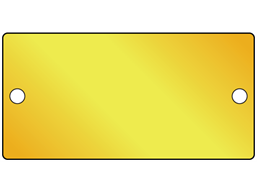Blank Metal Nameplates can be used for a number of different reasons. This includes marking plant, equipment, fixtures and fittings. They can be marked by stamping, engraving or laser engraving. These versatile blank nameplates are supplied both with a self-adhesive backing, and with drill holes, providing the customer with different fixing means to suit the requirements. Label Source provides a range of Blank Metal Nameplates in brass, stainless steel and anodised aluminium all supplied in a rectangular shape. The nameplates range in sizes from 15mm x 50mm to 51mm x 101mm and are supplied in packs of 100.
Anodised Aluminium Nameplates:

The Anodised Aluminium Nameplates come with drilled holes for fixing and a self-adhesive back. The nameplates are strong especially at low temperatures), lightweight, corrosive resistant, non-magnetic, non-toxic, high reflectivity, non-sparking with good electrical and thermal conductivity. These badges can suit all different requirements as they can be stamped or engraved, and marked for equipment valves, machinery, regulators and process plant.
Brass Nameplates:

These versatile Brass tags can be stamped or engraved, and can be used to mark equipment, valves, machinery, regulators and process plant. These brass nameplates arestrong, corrosive resistant, non-magnetic, electrically and thermally conductive, and have low friction properties (low spark emission).
Stainless Steel Nameplates:

These 304 grade Stainless Steel Nameplates (0.5mm thickness or 24 swg) are a low maintenance metal alloy, which has physical or mechanical properties of strength, hardness, and high ductility, but which are also chemical and stain resistant, and are able to be sterilised. Also, they can operate over a wide temperature range, both at low and high temperatures.
Any questions on our Blank Metal Nameplates please don’t hesitate to contact our sales office:
On 08003761693 in the UK
or +441443842769 for International calls outside of the UK
or email us on sales@labelsource.co.uk